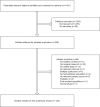Trace elements in hemodialysis patients: a systematic review and meta-analysis
- PMID: 19454005
- PMCID: PMC2698829
- DOI: 10.1186/1741-7015-7-25
Trace elements in hemodialysis patients: a systematic review and meta-analysis
Abstract
Background: Hemodialysis patients are at risk for deficiency of essential trace elements and excess of toxic trace elements, both of which can affect health. We conducted a systematic review to summarize existing literature on trace element status in hemodialysis patients.
Methods: All studies which reported relevant data for chronic hemodialysis patients and a healthy control population were eligible, regardless of language or publication status. We included studies which measured at least one of the following elements in whole blood, serum, or plasma: antimony, arsenic, boron, cadmium, chromium, cobalt, copper, fluorine, iodine, lead, manganese, mercury, molybdenum, nickel, selenium, tellurium, thallium, vanadium, and zinc. We calculated differences between hemodialysis patients and controls using the differences in mean trace element level, divided by the pooled standard deviation.
Results: We identified 128 eligible studies. Available data suggested that levels of cadmium, chromium, copper, lead, and vanadium were higher and that levels of selenium, zinc and manganese were lower in hemodialysis patients, compared with controls. Pooled standard mean differences exceeded 0.8 standard deviation units (a large difference) higher than controls for cadmium, chromium, vanadium, and lower than controls for selenium, zinc, and manganese. No studies reported data on antimony, iodine, tellurium, and thallium concentrations.
Conclusion: Average blood levels of biologically important trace elements were substantially different in hemodialysis patients, compared with healthy controls. Since both deficiency and excess of trace elements are potentially harmful yet amenable to therapy, the hypothesis that trace element status influences the risk of adverse clinical outcomes is worthy of investigation.
Figures


Similar articles
-
Selenium for preventing cancer.Cochrane Database Syst Rev. 2018 Jan 29;1(1):CD005195. doi: 10.1002/14651858.CD005195.pub4. Cochrane Database Syst Rev. 2018. PMID: 29376219 Free PMC article.
-
Trace elements and Alzheimer dementia in population-based studies: A bibliometric and meta-analysis.Environ Pollut. 2023 Feb 1;318:120782. doi: 10.1016/j.envpol.2022.120782. Epub 2022 Dec 1. Environ Pollut. 2023. PMID: 36464120
-
Systemic pharmacological treatments for chronic plaque psoriasis: a network meta-analysis.Cochrane Database Syst Rev. 2021 Apr 19;4(4):CD011535. doi: 10.1002/14651858.CD011535.pub4. Cochrane Database Syst Rev. 2021. Update in: Cochrane Database Syst Rev. 2022 May 23;5:CD011535. doi: 10.1002/14651858.CD011535.pub5. PMID: 33871055 Free PMC article. Updated.
-
Drugs for preventing postoperative nausea and vomiting in adults after general anaesthesia: a network meta-analysis.Cochrane Database Syst Rev. 2020 Oct 19;10(10):CD012859. doi: 10.1002/14651858.CD012859.pub2. Cochrane Database Syst Rev. 2020. PMID: 33075160 Free PMC article.
-
Comparison of cellulose, modified cellulose and synthetic membranes in the haemodialysis of patients with end-stage renal disease.Cochrane Database Syst Rev. 2001;(3):CD003234. doi: 10.1002/14651858.CD003234. Cochrane Database Syst Rev. 2001. Update in: Cochrane Database Syst Rev. 2005 Jul 20;(3):CD003234. doi: 10.1002/14651858.CD003234.pub2. PMID: 11687058 Updated.
Cited by
-
Heavy Metals in Dialysis Fluid and Blood Samples from Hemodialysis Patients in Dialysis Centers in Baghdad, Iraq.J Health Pollut. 2019 Aug 19;10(27):200901. doi: 10.5696/2156-9614-10.27.200901. eCollection 2020 Sep. J Health Pollut. 2019. PMID: 32874757 Free PMC article.
-
Blood Arsenic and Cadmium Concentrations in End-Stage Renal Disease Patients who were on Maintenance Haemodialysis.J Clin Diagn Res. 2013 May;7(5):809-13. doi: 10.7860/JCDR/2013/5351.2945. Epub 2013 Mar 18. J Clin Diagn Res. 2013. PMID: 23814716 Free PMC article.
-
Immunomodulatory and Anti-Inflammatory Properties of Selenium-Containing Agents: Their Role in the Regulation of Defense Mechanisms against COVID-19.Int J Mol Sci. 2022 Feb 21;23(4):2360. doi: 10.3390/ijms23042360. Int J Mol Sci. 2022. PMID: 35216476 Free PMC article. Review.
-
The Impact of Inflammatory Profile on Selenium Levels in Hemodialysis Patients.Antiinflamm Antiallergy Agents Med Chem. 2020;19(1):42-49. doi: 10.2174/1871523018666190121165902. Antiinflamm Antiallergy Agents Med Chem. 2020. PMID: 30666918 Free PMC article.
-
Circulatory Imbalance of Essential and Toxic Trace Elements in Pre-dialysis and Hemodialysis Patients.Biol Trace Elem Res. 2022 Jul;200(7):3117-3125. doi: 10.1007/s12011-021-02940-7. Epub 2021 Sep 29. Biol Trace Elem Res. 2022. PMID: 34586605 Free PMC article.
References
Publication types
MeSH terms
Substances
LinkOut - more resources
Full Text Sources
Other Literature Sources
Medical
Molecular Biology Databases

